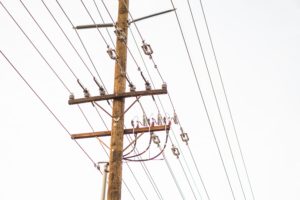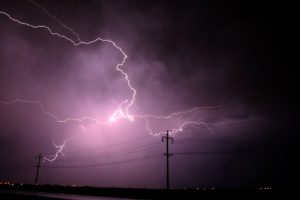The Dangers of Utility Poles to Humans
We all know electricity can be extremely dangerous. Because utility poles support so many electrical wires and cables, nearby residents and people walking by should be cautious, especially in the case that one is downed. Read on to find out more about utility poles and how you can keep your family safe.
 Utility Pole Facts
Utility Pole Facts
- Most utility poles are 35 feet tall although their height can range from 20 to 100 feet.
- Wood poles are usually made from Douglas fir, southern pine or western red cedar and can last 30 to 40 years.
- Modern utility poles are usually concrete, steel or fiberglass and last longer than their wood counterparts.
- Poles are buried six feet in the ground and spaced about 125 feet apart.
What is the Function of a Utility Pole?
Utility poles basically serve as a tool to secure the wires and devices that run electricity to homes and businesses. To better understand how they function, it is a good idea to become familiar with what is on a utility pole.
Transmission Wires: These are high voltage wires that can carry electricity of 69 to 500 kilovolts to substations where voltage is reduced.
Distribution Wires: Once power is reduced at the substations, to between 4 and 25 kilovolts, the distribution wires carry the power to homes and businesses.
Communication Lines: These carry cable television, telephone service and broadband to end users.
Transformer: These are large, metal canister shaped devices that convert high voltage to low voltage making it suitable for use in homes and businesses.
Dangers of Utility Poles
Though utility poles aren’t typically dangerous to those who walk by or live near them, there are situations that arise in which the poles can become a threat. Here are some things to look out for:
 Leaning Poles: Although poles are sturdy, they don’t last forever. Insect damage, high winds, old age or inclement weather are all factors that can lead to poles cracking. When this happens, a transformer can come crashing down causing injuries and property damage. Beware of poles that are leaning and report them to your local utility company.
Leaning Poles: Although poles are sturdy, they don’t last forever. Insect damage, high winds, old age or inclement weather are all factors that can lead to poles cracking. When this happens, a transformer can come crashing down causing injuries and property damage. Beware of poles that are leaning and report them to your local utility company.
Dangerous Voltage: Even though the power lines in urban areas tend to run at lower voltages, it still has potential to cause injuries if you touch these lines. Electric shocks can lead to severe internal damage and even death. You don’t have to actually touch a wire to get an electric shock. Tree branches can come in contact with a power line and energize the tree and the ground around it.
Stray Voltage: When insulation surrounding old wires underground begin to degrade, they come in contact with soil. Stray electrical currents can travel through the soil in to metal objects including steel utility poles, fire hydrants, manhole covers, etc. Touching these surfaces can cause electrical shock that can lead to injury and death.
Chemical Toxins: Wood utility poles are treated with preservatives to make them last longer and keep bugs away. Unfortunately, these preservatives contain dangerous chemicals which can harm humans and the environment, Cancer, birth defects, reproductive system and nervous system damage has occurred.
Unfortunately, there seems no way to prevent electric shock the can occur as a result of utility pole malfunctions, other than reporting obvious signs of damage and decay. It is also a good idea to understand how to deal with electric shock and situations in which a utility pole might put you in danger. Educate your family on possible hazards and do your best to keep yourself safe.
